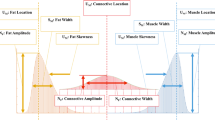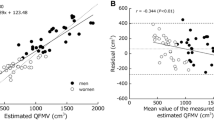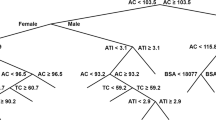Abstract
Knowledge of subject-specific muscle volumes may be used as surrogates for evaluating muscle strength and power generated by ‘fat-free’ muscle mass. This study presents population-based statistical learning approaches for predicting ‘fat-free’ muscle volume from known anthropometric measurements. Using computed tomography (CT) imaging data to obtain lower-limb muscle volumes from 50 men and women, this study evaluated six statistical learning methods for predicting muscle volumes from anthropometric measurements: (i) stepwise regression, (ii) linear support vector machine (SVM), (iii) 2nd-order polynomial SVM, (iv) linear partial least squares regression (PLSR), (v) quadratic PLSR, and (vi) 3rd-order spline fit PLSR. These techniques have successfully been demonstrated in bioengineering applications and freely available in open-source toolkits. Analysis revealed that separating a general population into sexes and/or cohorts based on adipose level may improve prediction accuracies. The most important measures that statistically influence muscle volume predictions were shank girth, followed by sex and finally leg length, as identified using stepwise regression. SVM learning predicted muscle volume with an accuracy of 85 ± 4% when using linear interpolation, but performed poorly with an accuracy of 59 ± 6% using polynomial interpolation. The simpler linear PLSR exhibited muscle volume prediction accuracy of 87 ± 2%, while quadratic PLSR was slightly reduced at 82 ± 3%. For the spline fit PLSR, high accuracy was observed on the training data set (~ 99%) but over-fitting (a drawback of high-interpolation methods) resulted in erroneous predictions on testing data, and hence, the model was deemed unsuitable. In conclusion, use of linear PLSR models with variables of sex, leg length, and shank girth is a useful tool for predicting ‘fat-free’ muscle volume.



Similar content being viewed by others
References
Akagi R, Takai Y, Ohta M, Kanehisa H, Kawakami Y, Fukunaga T (2009) Muscle volume compared to cross-sectional area is more appropriate for evaluating muscle strength in young and elderly individuals. Age Ageing 38:564–569. https://doi.org/10.1093/ageing/afp122
Arnold EM, Ward SR, Lieber RL, Delp SL (2010) A model of the lower limb for analysis of human movement. Ann Biomed Eng 38:269–279. https://doi.org/10.1007/s10439-009-9852-5
Baker JS, Bailey DM, Davies B (2001) The relationship between total-body mass, fat-free mass and cycle ergometry power components during 20 seconds of maximal exercise. J Sci Med Sport 4:1–9
Barrett RS, Lichtwark GA (2010) Gross muscle morphology and structure in spastic cerebral palsy: a systematic review. Dev Med Child Neurol 52:794–804. https://doi.org/10.1111/j.1469-8749.2010.03686.x
Bryan R, Nair PB, Taylor M (2009) Use of a statistical model of the whole femur in a large scale, multi-model study of femoral neck fracture risk. J Biomech 42:2171–2176. https://doi.org/10.1016/j.jbiomech.2009.05.038
Bryan R, Mohan PS, Hopkins A, Galloway F, Taylor M, Nair PB (2010) Statistical modelling of the whole human femur incorporating geometric and material properties. Med Eng Phys 32:57–65. https://doi.org/10.1016/j.medengphy.2009.10.008
Carbone V et al (2015) TLEM 2.0-A comprehensive musculoskeletal geometry dataset for subject-specific modeling of lower extremity. J Biomech 48:734–741. https://doi.org/10.1016/j.jbiomech.2014.12.034
Chen BB et al (2011) Thigh muscle volume predicted by anthropometric measurements and correlated with physical function in the older adults. J Nutr Health Aging 15:433–438
Fernandez J, Mithraratne K, Alipour M, Handsfield GG, Besier TF, Zhang J (2018) Towards rapid prediction of personalised muscle mechanics: integration with diffusion tensor imaging. Comput Methods Biomech Biomed Eng Imaging Vis. https://doi.org/10.1080/21681163.2018.1519850
Ferreira A, Gentil F, Tavares JM (2014) Segmentation algorithms for ear image data towards biomechanical studies. Comput Methods Biomech Biomed Eng 17:888–904. https://doi.org/10.1080/10255842.2012.723700
Fukunaga T, Miyatani M, Tachi M, Kouzaki M, Kawakami Y, Kanehisa H (2001) Muscle volume is a major determinant of joint torque in humans. Acta Physiol Scand 172:249–255
Handsfield GG, Meyer CH, Hart JM, Abel MF, Blemker SS (2014) Relationships of 35 lower limb muscles to height and body mass quantified using MRI. J Biomech 47:631–638
Handsfield GG, Meyer CH, Abel MF, Blemker SS (2016) Heterogeneity of muscle sizes in the lower limbs of children with cerebral palsy. Muscle Nerve 53:933–945. https://doi.org/10.1002/mus.24972
Handsfield GG, Knaus KR, Fiorentino NM, Meyer CH, Hart JM, Blemker SS (2017) Adding muscle where you need it: non-uniform hypertrophy patterns in elite sprinters. Scand J Med Sci Sports 27:1050–1060. https://doi.org/10.1111/sms.12723
Herskind A, Ritterband-Rosenbaum A, Willerslev-Olsen M, Lorentzen J, Hanson L, Lichtwark G, Nielsen JB (2016) Muscle growth is reduced in 15-month-old children with cerebral palsy. Dev Med Child Neurol 58:485–491. https://doi.org/10.1111/dmcn.12950
Holzbaur KR, Murray WM, Gold GE, Delp SL (2007) Upper limb muscle volumes in adult subjects. J Biomech 40:742–749
Horsman MDK, Koopman HFJM, van der Helm FCT, Prose LP, Veeger HEJ (2007) Morphological muscle and joint parameters for musculoskeletal modelling of the lower extremity Clin Biomech 22:239–247. https://doi.org/10.1016/j.clinbiomech.2006.10.003
James G, Witten D, Hastie T, Tibshirani R (2013) An introduction to statistical learning with application in R, 1st edn. Springer, Springer texts in Statistics
Karlsson A, Rosander J, Romu T, Tallberg J, Gronqvist A, Borga M, Leinhard OD (2015) Automatic and quantitative assessment of regional muscle volume by multi-atlas segmentation using whole-body water-fat MRI. J Magn Reson Imaging 41:1558–1569. https://doi.org/10.1002/jmri.24726
Larsson L, Grimby G, Karlsson J (1979) Muscle strength and speed of movement in relation to age and muscle morphology. J Appl Physiol 46:451–456
Lee RC, Wang Z, Heo M, Ross R, Janssen I, Heymsfield SB (2000) Total-body skeletal muscle mass: development and cross-validation of anthropometric prediction models. Am J Clin Nutr 72:796–803
Lindle R et al (1997) Age and gender comparisons of muscle strength in 654 women and men aged 20–93 yr. J Appl Physiol 83:1581–1587
Ma Z, Tavares JM, Jorge RN, Mascarenhas T (2010) A review of algorithms for medical image segmentation and their applications to the female pelvic cavity. Comput Methods Biomech Biomed Eng 13:235–246. https://doi.org/10.1080/10255840903131878
Mersmann F, Bohm S, Schroll A, Boeth H, Duda G, Arampatzis A (2015) Muscle shape consistency and muscle volume prediction of thigh muscles. Scand J Med Sci Sports 25:e208–e213
Mitsiopoulos N, Baumgartner RN, Heymsfield SB, Lyons W, Gallagher D, Ross R (1998) Cadaver validation of skeletal muscle measurement by magnetic resonance imaging and computerized tomography. J Appl Physiol 85:115–122
Narici MV, Maganaris CN, Reeves ND, Capodaglio P (2003) Effect of aging on human muscle architecture. J Appl Physiol 95:2229–2234. https://doi.org/10.1152/japplphysiol.00433.2003
Oliveira RB, Filho ME, Ma Z, Papa JP, Pereira AS, Tavares JM (2016) Computational methods for the image segmentation of pigmented skin lesions: a review. Comput Methods Programs Biomed 131:127–141. https://doi.org/10.1016/j.cmpb.2016.03.032
Rao C, Fitzpatrick CK, Rullkoetter PJ, Maletsky LP, Kim RH, Laz PJ (2013) A statistical finite element model of the knee accounting for shape and alignment variability. Med Eng Phys 35:1450–1456. https://doi.org/10.1016/j.medengphy.2013.03.021
Rosipal R, Trejo LJ (2011) Nonlinear partial least squares: an overview. In: H. Lodhi, Y. Yamanishi (eds) Chemoinformatics and advanced machine learning perspectives: complex computational methods and collaborative techniques. ACCM, IGI Global, pp. 169–189
Smola AJ, Schölkopf B (2004) A tutorial on support vector regression. Stat Comput 14:199–222
Wold S, Ruhe A, Wold H, Dunn WJ (1984) The collinearity problem in linear-regression—the partial least-squares (Pls) approach to generalized inverses. SIAM J Sci Stat Comp 5:735–743. https://doi.org/10.1137/0905052
Wu T, Martens H, Hunter P, Mithraratne K (2014) Emulating facial biomechanics using multivariate partial least squares surrogate models. Int J Numer Methods Biomed Eng 30:1103–1120
Zhang J, Besier TF (2017) Accuracy of femur reconstruction from sparse geometric data using a statistical shape model. Comput Methods Biomech Biomed Eng 20:566–576. https://doi.org/10.1080/10255842.2016.1263301
Zhang J et al (2014) The MAP client: user-friendly musculoskeletal modelling workflows. Lect Notes Comput Sci 8789:182–192
Zhang J, Hislop-Jambrich J, Besier TF (2016) Predictive statistical models of baseline variations in 3-D femoral cortex morphology. Med Eng Phys 38:450–457. https://doi.org/10.1016/j.medengphy.2016.02.003
Zheng L, Siegmund G, Ozyigit G, Vasavada A (2013) Sex-specific prediction of neck muscle volumes. J Biomech 46:899–904
Author information
Authors and Affiliations
Corresponding author
Ethics declarations
Conflict of interest
The authors declare that they have no conflict of interest.
Additional information
Publisher's Note
Springer Nature remains neutral with regard to jurisdictional claims in published maps and institutional affiliations.
Appendix
Appendix
1.1 Stepwise regression
Stepwise linear regression was used to determine the optimal subset of anthropometric parameters needed to predict muscle volume. The stepwise regression model used in this study has a forward selection approach, which starts with no variables followed by adding one variable at a time to test and compare criterion for any improvements to the model. The criterion used to assess improvement in this study was the Akaike information criteria (AIC) fitness criterion (James et al. 2013) defined by
where k is the number of estimated parameters in the model and L is the maximum value of the likelihood function for the model. This process is repeated until no improvements to the model are observed and parameters are ranked according to significance.
1.2 SVM
Support vector machine is a supervised machine learning method used for classification and regression of data. With a training data set, categories are defined and a function is used to design a hyper-plane (multidimensional plane) that splits and classifies data into categorical classes, denoted C. This non-probabilistic linear classifier, C, defines minimised weight vectors, w, of the function
that maximises the difference from both classes (Smola and Schölkopf 2004), where ζi is the distance between data point, i, and the plane (known as a support vector).Therefore, new data are mapped onto the functional space and defined as the class based on its relative position to the hyper-plane and the training data set categories. In this study, n is 50 and the classes were shank girth, sex, and leg length.
A polynomial SVM differs in that it uses a polynomial function for the internal linear kernel. For this study, we used a 2nd-order polynomial (quadratic) as the defining function, which results in a nonlinear weighting and scaling factors. The linear and polynomial SVM used in this study was from the standard python library (http://scikit-learn.org/stable/modules/svm.html).
1.3 Linear PLSR
Partial least squares regression (PLSR) (Wold et al. 1984) was used to model the relationships between total muscle volume and anthropometric measurements, thereby creating a total muscle volume predictor. The two fundamental equations in PLSR are the predictor matrix (X) and the response matrix (Y) given by
and
where N is the number of data sets (50 in this study), M is the number of predictor variables (being shank girth, sex, and leg length), P is the number of response variables (muscle volume), and L is the number of principal components. T and U are the projection matrices (also known as scores), and P and Q are the transposed orthogonal loading matrices (where the rows are created from eigenvectors or principal components), and E and F are the error or residual terms. The score vectors are related using a linear function
where H is the vector of residuals. For quadratic PLSR, a nonlinear relationship can be used to relate U and T of the form
where ci represents quadratic fitting constants. For 3rd-order spline PLSR, the relationship between the scores is given using a cubic spline function
Rights and permissions
About this article
Cite this article
Yeung, S., Fernandez, J.W., Handsfield, G.G. et al. Rapid muscle volume prediction using anthropometric measurements and population-derived statistical models. Biomech Model Mechanobiol 19, 1239–1249 (2020). https://doi.org/10.1007/s10237-019-01243-0
Received:
Accepted:
Published:
Issue Date:
DOI: https://doi.org/10.1007/s10237-019-01243-0




